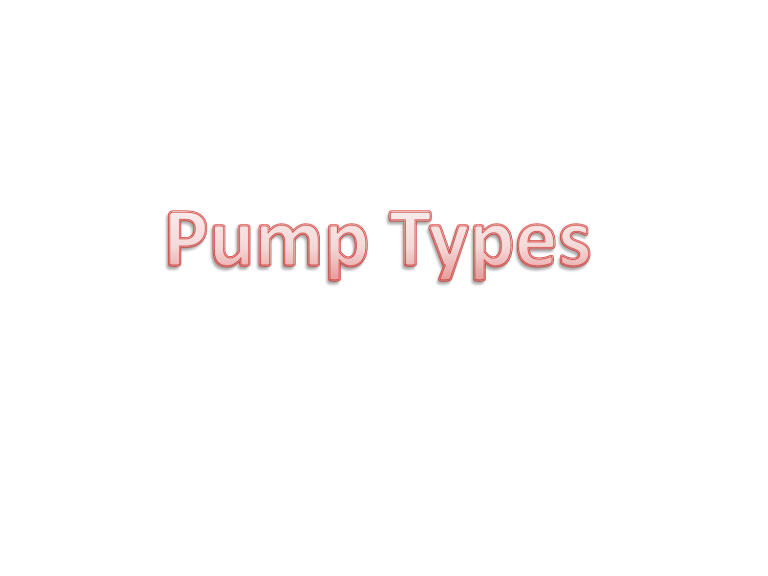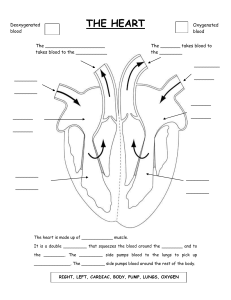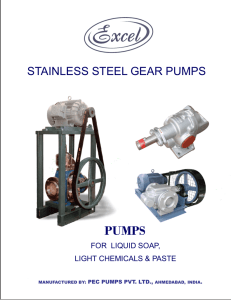
The pump sucks oil out of the tank and pushes it through a directional control valve to the cylinder The flow rate of the fluid and hence the speed of the piston is produced by the pump and this depends on the size, type and speed of the pump. Pumps are divided into two categories 1. Non positive displacement types 2. Positive displacement types Non positive displacement types The two main types in this category are 1. Centrifugal 2. Axial Continuous flow is produced by a rotating impeller. There is no positive seal between the inlet and outlet and if the impeller was stopped, flow could be forced through it. Positive displacement types Nearly all power hydraulic systems use positive displacement pumps. In such pumps, there is ideally no internal slippage and the amount of liquid pumped is the same for each revolution regardless of the pressure. The piston pump illustrated is a good example of this. The piston sucks in and pushes out a fixed volume for every revolution of the shaft. This is called the NOMINAL DISPLACEMENT. Flow Rate = Nominal Displacement x Shaft Speed. In reality the mating components are not a perfect fit and so small leaks may occur past the valves and pistons. The leakage increases with pressure and a graph of flow against pressure is as shown. Pump Symbols The basic symbol is a circle with a black triangular arrow head showing the direction of flow. Rotary Pumps Rotary pumps are capable of pumping more fluid than reciprocating pumps of the same weight. Rotary pumps are self-priming and deliver a constant, smooth flow, regardless of pressure variations. Ex: Gear Pumps (External and Internal), Vane Pumps, Lobe pumps, Screw pumps, Gerotor pumps GEAR PUMPS 1. External Gear Pumps In external gear pump uses two identical gears rotating against each other. One gear is driven by a motor and it turn the other gear. Each gear is supported by a shaft with bearings on both sides of the gear. External gear pumps are used for high-pressure applications such as hydraulic applications. 1. As the gears come out of mesh, they create expanding volume on the inlet side of the pump. Liquid flows into the cavity and is trapped by the gear teeth as they rotate. 2. Liquid travels around the interior of the casing in the pockets between the teeth and the casing. It does not pass between the gears. 3. Finally, the meshing of the gears forces liquid through the outlet port under pressure. 2. Internal Gear Pumps 1. Liquid enters the suction port between the rotor (large exterior gear) and idler (small interior gear) teeth. 2. Liquid travels through the pump between the teeth of the "gear-within-a-gear" principle. The crescent shape divides the liquid and acts as a seal between the suction and discharge ports. 3. The pump head is now nearly flooded, just prior to forcing the liquid out of the discharge port. Intermeshing gears of the idler and rotor form locked pockets for the liquid which assures volume control. 4. Rotor and idler teeth mesh completely to form a seal equidistant from the discharge and suction ports. This seal forces the liquid out of the discharge port. They are often used on thin liquids such as solvents and fuel oil, they excel at efficiently pumping thick liquids such as asphalt, chocolate, and adhesives. LOBE PUMP 1. As the lobes come out of mesh, they create expanding volume on the inlet side of the pump. Liquid flows into the cavity and is trapped by the lobes as they rotate. 2. Liquid travels around the interior of the casing in the pockets between the lobes and the casing. It does not pass between the lobes. 3. Finally, the meshing of the lobes forces liquid through the outlet port under pressure. Lobe pumps are used in a variety of industries including, pulp and paper, chemical, food, beverage, pharmaceutical, and biotechnology. They offer superb sanitary qualities, high efficiency, reliability, corrosion resistance, and good clean-in-place Lobe pumps are frequently used in food applications because they handle solids without damaging the product. VANE PUMPS 1. In a vane pump the rotor has radial slots into which there are vanes. 2. As the rotor rotates (yellow arrow) and fluid enters the pump, centrifugal force, hydraulic pressure, and/or pushrods push the vanes to the walls of the housing. 3. The housing and cam force fluid into the pumping chamber through holes in the cam. Fluid enters the pockets created by the vanes, rotor, cam, and sideplate. 4. As the rotor continues around, the vanes sweep the fluid to the opposite side of the crescent where it is squeezed through discharge holes of the cam as the vane approaches the point of the crescent (small red arrow on the side of the pump). Fluid then exits the discharge port. While vane pumps can handle moderate viscosity liquids, they excel at handling low viscosity liquids such as LP gas (propane), ammonia, solvents, alcohol, fuel oils, gasoline, and refrigerants. GEROTOR PUMPS Gerotor pumps are internal gear pumps without the crescent. The rotor is the internal (drive) gear shown below in gray, and the idler is the external (driven) gear, shown below in yellow. 1. Liquid enters the suction port between the rotor (gray gear) and idler (yellow gear) teeth. 2. Liquid travels through the pump between the teeth of the "gear-within-a-gear" principle. The close tolerance between the gears acts as a seal between the suction and discharge ports. 3. Rotor and idler teeth mesh completely to form a seal equidistant from the discharge and suction ports. This seal forces the liquid out of the discharge port. They are primarily suitable for clean, low pressure applications such as lubrication systems or hot oil filtration systems SCRW PUMPS Screw pumps carry fluid in the spaces between the screw threads. The fluid is displaced axially as the screws mesh. Each ‘screw pump’ operates on the same basic principal of a screw turning to isolate a volume of fluid and convey it. According to the mechanical design this pump type can be divided in to three types; 1. Single screw pump 2. Two screw pump 3. Tree screw pump Two Screw Pump The pumping element of a two screw pump consists of two intermeshing screws rotating within a stationary bore/housing. Can use for the severe applications in aggressive fluid handling. Reciprocating Pump Reciprocating pump is a positive displacement pump. They are used widely in lifting water from ground to the storage tanks in residential areas. Reciprocating pump consists of "suction stroke" and a "delivery stroke". Suction stroke is the place where the water is sucked in from the ground and delivery stroke is the place where the sucked water is delivered to the required place. During the suction stroke the piston is moved backward and the inlet valve opens and water enters in exit valve will be closed. During delivery stroke the piston moves inward by forcing the water through the outlet valve but the inlet valve remains closed. Ex: Radial pumps , Axial Piston pumps Axial Piston Pump In axial piston pumps, the pistons reciprocate parallel to the axis of rotation of the cylinder block. The cylinder block in this pump is turned by the drive shaft. The ports are arranged in the valve plate so that the pistons pass the inlet as they are pulled out and pass the outlet as they are forced back in. Radial Piston Pump Radial Piston pumps include a rotating cylinder containing equally spaced radial pistons arranged radial around the cylinder centre line. A springs pushes the pistons against the inner surface of an encircling stationay ring mounted eccentric to the cylinder. The pistons draw in fluid during half a revolution and drive fluid out during the other half. The greater the ring eccentricity the longer the pistons stroke and the more fluid they transfer.




